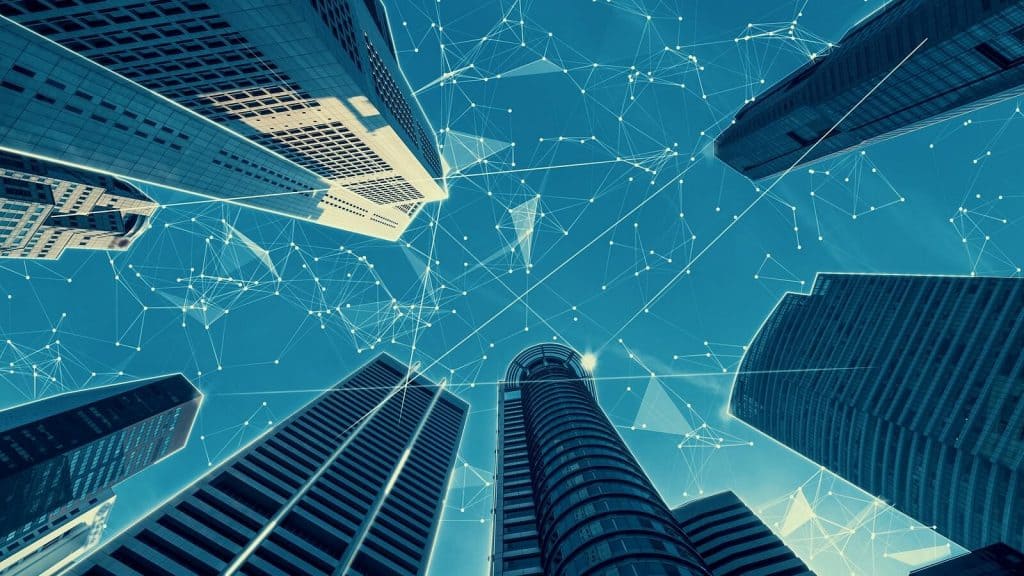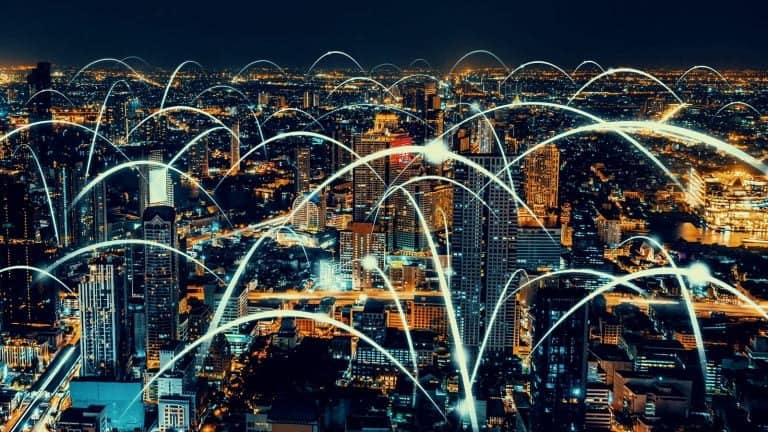The smart city concept has been all the rage for several years. Smart cities are touted as the panacea to problems created by urbanization. As the world population moves to cities, adverse outcomes such as pollution, unsustainable energy usage, crime, poor mobility, and inadequate infrastructure are likely to increase. Turning to smart city solutions allows cities to grow sustainably and improve the quality of residents’ lives. But, while there has been a lot of talk about smart cities, there isn’t much consensus on the features of a smart city. All the indices that measure smart city status use different parameters. So, what are the features of a smart city?
Frost and Sullivan, a leading consulting firm, provided one of the most coherent views on the features of a smart city project. There are eight key features of a smart city: smart building, smart infrastructure, smart energy, smart technology, smart mobility, smart healthcare, smart governance, and smart citizens.
(Source: Frost and Sullivan)
Below, we examine each features of a smart city in detail.
- Smart Building
In smart cities, commercial buildings evolve to cater to workplace behavior and technological changes while presenting new opportunities to maximize productivity and efficiency. Industries and companies in a smart city demand versatile facilities that serve as virtual gateways to connect people within an office and worldwide. Smart buildings integrate people and systems functionally and dynamically. Building owners have the challenge of providing safe and secure environments, functional spaces, network connectivity, and IoT setup that enables improved productivity.
The first step in creating safe and secure environments is by implementing risk management. This is achieved through a layered approach that provides you with the ability to prevent entry, discover, refuse admission, defend, and detect entry at every smart building layer. Different areas of the building usually adopt various security solutions such as network intrusion detection, integrated access control, video surveillance, and fire protection systems.
In smart buildings, high-performance fiber optic systems play a vital role in operating the facility. It helps support multiple applications, eliminate network downtime, and cope with increased bandwidth. Versatile physical layer network connectivity depends on a universal cabling topology, well-designed network flexibility, wireless mobility, media selection, and multi-application support. Hardware and software must work in conjunction to improve network productivity and efficiency.
Smart buildings must be able to support BYOD (Bring Your Own Device) environments and collaborative communications. They must also surmount the restrictions of legacy systems and achieve regulatory compliance.
With more employees concentrated in smaller spaces and with greater demand for flexible, collaborative working areas, space optimization is essential in smart buildings. Optimization improves workforce productivity and efficiency and that of the building. 5G Wifi and fixed network connectivity, professional audio/visual solutions, and energy-efficient lighting help optimize the building’s effectiveness.
Enabling the IoT in a building allows real estate managers to analyze their environments and make real-time adjustments that enhance efficiency and productivity. Truly smart buildings address the challenges posed by open architecture designs, supplier integration, and IP platform migration. IoT-enabled environments simplify risk management, network performance, workforce productivity, and space utilization tasks.
- Smart Infrastructure
In smart cities, the ecosystem of industries, grids, and buildings changes fast. Simple, centralized energy legacy systems morph into complex distributed systems and creating opportunities. For example, buildings transform from passive to smart, even becoming both energy consumers and producers. Buildings in a smart city are an active component of the energy system. This requires a new way of thinking by city officials.
Smart Cities strive to improve infrastructure and service delivery by leveraging technology, information, and data. This includes access to water, electricity, affordable homes, education and health services, and IT connectivity. The ecosystem must intuitively respond to the citizens’ needs and help them use their resources more sustainably.
- Smart Mobility
One of the most complex challenges of our time is managing urban mobility. New mobility options such as ride-sharing and car-sharing are not always an ideal solution. For example, with car sharing, you have to drive and look for parking space and aren’t guaranteed to find a car when you need one. There is no way to ensure optimal vehicle occupancy with ride-sharing, which means you still end up with too many vehicles on the road than is necessary. In many cities, ride-sharing is also usually a source of conflict with regular public transport operators. So, how does a city create an urban mobility model that responds to the needs of its citizens?
The future of mobility involves self-driving vehicles, electric cars and buses, ride-sharing, hyper-loop intra-city transit systems, e-bikes, hoover boards, and much more. These are all current ideas in the early implementation, pilot phase, or development. Smart mobility changes how city residents use their time, enjoy their commute, and spend their money.
But, public transportation is just one facet of the smart mobility landscape. Smart mobility is much more than cool new ways to commute. Smart mobility also includes travel booking applications that make use of digital money and technology that connects travel infrastructure to citizens. It also includes systems that coordinate public transport vehicles using predictive analytics to ensure availability when and where they are required.
Smart cities have an assortment of transport modes. Initiatives such as intelligent traffic management, smart parking, and integrated multi-modal transport, all enhance urban mobility.
The city is also more pedestrian (and cyclist) friendly, and residents can walk or cycle.
- Smart Energy
Smart cities are not powered conventionally. National grids are upgraded, and energy assets are decentralized. There is also a shift to electric vehicles. Smart energy is a move towards a smarter energy infrastructure with greater efficiency, new revenue potential, and a cleaner, greener environment.
Smart energy offers smart cities five main opportunities; cost savings, decarbonization, resilience, and greater capacity.
For new urban developments smart energy allows cities to use the right technology mix while considering the entire lifecycle value of all inputs.
By controlling energy assets, cities can repurpose existing infrastructure to develop tradeable assets and income streams. Collections of energy assets are turned into micro-energy stations that return excess energy to the grid.
Smart energy leads to massive cost savings to run public and private infrastructure. Smart energy applications allow cities to understand their energy demand profile. Officials can understand dominant loads, daily fluctuations and prioritize reduced consumption. Methods such as load shifting and demand-side response help reduce costs by avoiding peak times and usage time; significant savings are realized by the city and energy consumers.
Pollution is one of the biggest drawbacks of rapid urbanization. Many cities have declared climate emergencies. Smart energy allows large-scale decarbonization.
Smart energy leads to the democratization of energy consumption. Logistic and technological barriers to energy access are eliminated.
The decentralization of energy also makes it more resilient. Smart energy policies effectively deal with the intermittency of power balancing of new and renewable energy sources and protecting vital supply.
- Smart Technology
In smart cities, technology is used on a large scale to alleviate the problems caused by urbanization and improve the quality of life. Technological implementations in a smart city include generating energy and creating fertilizer from the city’s waste, reducing waste generated during building construction, restoration, and destruction, and managing scarce water resources more sustainably.
- Smart Healthcare
In smart cities, the IoT improves access to quality health care and reduces costs by tracking patients, equipment, employees, and much more. Smart healthcare has only just begun to scratch the surface; the possibilities are infinite.
Extending healthcare to the home in smart cities is making data collection and wellness tracking possible. This development is changing chronic disease management. This data is seamlessly integrated into electronic health records allowing doctors to monitor patients in real-time remotely. In smart cities, it is more common for patients to meet doctors from the comfort of their living rooms through telemedicine.
Augmented reality that uses digital images, superimposed on live content and virtual reality, an artificial 3D environment, are some of the hottest technologies today. They are used in smart healthcare to treat addiction, phobias, and post-traumatic stress disorder. They are also used in learning to teach medical students about anatomy and surgical techniques.
Artificial Intelligence (AI), in conjunction with natural language processing, provides clinical decision support. In future smart cities, AI could break through boundaries in ways that are currently inconceivable.
- Smart Governance
Smart cities have improved public participation through the use of e-government tools and initiatives. Government services are predominantly delivered online via smartphones and other digital devices. This makes public services more affordable, accountable, and transparent.
In smart cities, the residents actively participate in governance and provide feedback via various digital channels.
- Smart Citizen
Finally, one of the essential features of a smart city is smart citizens. Smart citizens make smart cities. Many first-generation smart cities have neglected this human aspect. It is illogical to surround human beings with technology if they don’t know how to use it. For example, if citizens do not know how to access and use an intelligent scheduling public transport platform, they will continue using antiquated commute methods. And, the human element isn’t just about the residents being able to leverage information. It is also about them contributing to the further development of smart city initiatives. Officials must have elaborate civic education programs that empower citizens to use smart technologies.





